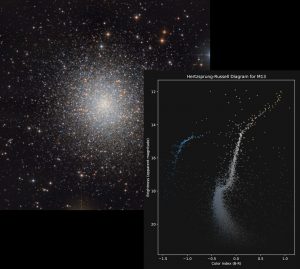2019 June 13

M13的颜色和星等
影像提供与版权: Tolga Gumusayak, Robert Vanderbei
说明: M13又称为武仙座大球状星团。在这个距离我们约25,000光年远的球形天体里,数十万颗成员星挤在宽约150光年的空间之内。这张图片左上角的M13之清晰彩色身影,是许多用望远镜巡天者很熟悉的景观。较特殊的,或许是右下使用同一组数据制作,带有更多资讯的M13之颜色-星等图。这种又称为赫罗(HR)图的图表,是以每颗成员星的视亮度相对于它的色指数作图。每颗星的色指数,定义为它透蓝光滤镜量测、以星等为单位的视亮度,减法红光滤镜的星等视亮度(B-R)。因为星色泛蓝的恒星温度较高,色泽偏红的恒星温度较低,所以在这种天文学图表上,色指数由左(高温)向右(低温)递增。在M13的赫罗图上,恒星有明显的分群现象。从右下角向左上对角伸展的带状区,是这个星团的主星序。向右上角弯折的是红巨星支,而左上角的分支则是蓝巨星。几乎同时诞生的M13成员星,刚开始时全都按质量依序分布在主星序上,较小质量的恒星位在右下角。随着时间推移,较大质量的恒星已演化离开主星序,先成为红巨星,接着再演化成蓝巨星及其他天体。由这个星团从主星序折向红巨星支的位置,可以推测它的年龄约有120亿年。
The Colors and Magnitudes of M13
Image Credit & Copyright: Tolga Gumusayak, Robert Vanderbei
Explanation: M13 is modestly recognized as the Great Globular Star Cluster in Hercules. A ball of stars numbering in the hundreds of thousands crowded into a region 150 light years across, it lies some 25,000 light-years away. The sharp, color picture of M13 at upper left is familiar to many telescopic imagers. Still, M13’s Color vs Magnitude Diagram in the panel below and right, made from the same image data, can offer a more telling view. Also known as a Hertzsprung Russell (HR) diagram it plots the apparent brightness of individual cluster stars against color index. The color index is determined for each star by subtracting its brightness (in magnitudes) measured through a red filter from its brightness measured with a blue filter (B-R). Blue stars are hot and red stars are cool so that astronomical color index ranging from bluer to redder follows the relative stellar temperature scale from left (hot) to right (cool). In M13’s HR diagram, the stars clearly fall into distinct groups. The broad swath extending diagonally from the bottom right is the cluster’s main sequence. A sharp turn toward the upper right hand corner follows the red giant branch while the blue giants are found grouped in the upper left. Formed at the same time, at first M13’s stars were all located along the main sequence by mass, lower mass stars at the lower right. Over time higher mass stars have evolved off the main sequence into red, then blue giants and beyond. In fact, the position of the turn-off from the main sequence to the red giant branch indicates the cluster’s age at about 12 billion years.







One Comment